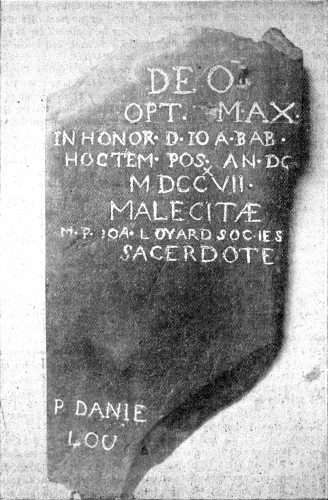Meductic Indian Village / Fort Meductic
| Fort Meductic | |
|---|---|
| near the confluence of the Eel River and Saint John River, in New Brunswick, | |
|
Meductic Church Cornerstone (1717). Oldest Christian religious artifact in New Brunswick. Discovered 1890.[1] | |
| Site information | |
| Controlled by | Maliseet |
| Site history | |
| Built | before the 17th century, first fort in Acadia |
| Battles/wars | |
| Official name | Meductic Indian Village / Fort Meductic National Historic Site of Canada |
| Designated | 1924 |

Meductic Indian Village / Fort Meductic (also known as Medoctec, Mehtawtik meaning "the end of the path") was a Maliseet settlement until the mid-eighteenth century. It was located near the confluence of the Eel River and Saint John River in New Brunswick, four miles upriver from present-day Meductic, New Brunswick.[2] The fortified village of Meductic was the principal settlement of the Maliseet First Nation from before the 17th century until the middle of the 18th, and it was an important fur trading centre. (The other two significant native villages in the region were the Abenaki village of Norridgewock (present-day Madison, Maine) on the Kennebec River and Penobscot (present-day Penobscot Indian Island Reservation) on the Penobscot River. Only during King George's War, after the French established Saint Anne (present-day Fredericton, New Brunswick), did the village Aukpaque, present-day Springhill, New Brunswick, become of equal importance to Meductic).[3]
The village contained Fort Meductic, which the Maliseet had built before the arrival of the French to defend against Mohawk attacks.[4] The Mohawk were one of the Five Nations of the Iroquois Confederacy, based in present-day New York, south of the St. Lawrence River and generally west of the Hudson River. This is reported to have been the first Fort in Acadia.[5]
Father Joseph Aubery re-established the mission in 1701. During the lead up to Father Rale's War, to secure the French influence on the village, Priest Jean-Baptiste Loyard built the chapel Saint Jean Baptiste (1717).[6] (The bell was given by King Louis XV.) [7] Similarly, the French claimed territory on the Kennebec River by building a church in the Abenaki village of Norridgewock.[8][9]
Meductic is a National Historic Site of Canada. A Historic Sites and Monuments Board of Canada plaque and cairn marking the site is located nearby on Fort Meductic Road. Official recognition refers to the polygon around the archaeological remains.[10]
See also
Footnotes
- ↑ Latin inscription: "To God, most excellent, most high, in honor of Saint John Baptist, the Maliseet erected this church A. D. 1717, while Jean Loyard, a priest of the Society of Jesus, was procurator of the mission.” (See Raymond, P.9)
- ↑ The village, dating from before the 17th century, was situated on a plateau west of the Saint John River. In 1968 the government acquired the Meductic site for the Mactaquac Dam, which flooded much of the Saint John River valley, including Meductic.
- ↑ Raymond, p. 3, p. 11, p. 16
- ↑ Raymond, p. 7
- ↑ Raymond, p. 11; Bishop Jean-Baptiste de La Croix de Chevrières de Saint-Vallier visited the area on the way to Port Royal, Nova Scotia. He wrote: "Megogtek is the first fort in Acadia".
- ↑ Binasco, Matteo. The Role and Activities of the Capuchin, Jesuit and Recollet Missionaries in Acadia/Nova Scotia from 1654 to 1755. Saint Mary’s University, Halifax, NS. 2004. Note: Father Loyard was born at Pau in 1678 (dept. of Pyrénées-Atlantique). He was ordained a Jesuit priest (Societe of Jesus) and served in Acadia from 1709 until his death in 1731.
- ↑ Raymond, p. 13
- ↑ "Meductic Indian Village / Fort Meductic National Historic Site of Canada". Parks Canada. Retrieved December 20, 2011.
- ↑ John Grenier, The Far Reaches of Empire. University of Oklahoma Press, 2008, p. 51, p. 54.
- ↑ Meductic Indian Village / Fort Meductic. Canadian Register of Historic Places. Retrieved 22 February 2012.
References
Secondary Sources:
- W.O. Raymond. The Old Meductic Fort and the Indian Chapel of Saint Jean Baptiste: paper read before the New Brunswick Historical Society (1897)
- Raymond, William O (1905). Glimpses of the Past: History of the River St. John. Saint John, NB: unspecified. OCLC 422037263.
- John Grenier. (2008). The Far Reaches of Empire: War in Nova Scotia 1710-1760. University of Oklahoma Press.
- Francis Parkman, The Jesuits in North America, Gutenberg Project
- Pouliot, Léon (1979–2016). "Loyard, Jean-Baptiste". Dictionary of Canadian Biography (online ed.). University of Toronto Press.
- Matteo Binasco. "Few, Uncooperative, and Endangered: The Troubled Activity of the Roman Catholic Missionaries in Acadia (1610-1710)", in Royal Nova Scotia Historical Society, Journal, vol.10 (2007), pp. 147–162.
External Links
| Wikimedia Commons has media related to Meductic Indian Village / Fort Meductic. |
Coordinates: 45°59′53″N 67°29′40″W / 45.99806°N 67.49444°W
